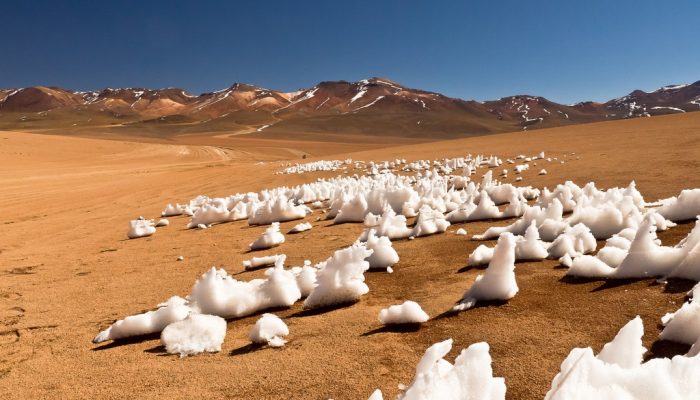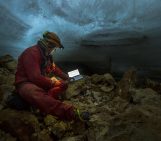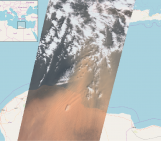
What do Chile and Jupiter’s moon Europa have in common? If you like astronomy, you may reply “space missions!” – Chile’s dry air and clear skies make it an ideal location for telescopes like the VLT or ALMA, while Europa’s inferred subsurface ocean will be studied by the upcoming mission to Jupiter JUICE, due to launch in 2022. But Chile’s high altitude Atacama desert and Europa’s frozen surface also have another feature in common, as you can see in this Image of the Week: ice spikes!
Penitentes is the word
The official name of these ice spikes is “Penitentes”, Spanish for penitents. Why? As you might see (with quite some imagination) on the Image of the Week, there is some resemblance with a kneeling and praying procession.
Fields of penitentes ranging from a few centimetres to five metres can be found above 4000 m altitude both in the Andes and Himalayas, the only places on Earth where the right conditions exist for their formation. Because although it looks as if the snow is just blown into penitentes by unidirectional winds, in reality everything is due to thermodynamics…
I promise I will not write the equations this time (see this previous post); instead, I invite you to read them in this paper. In summary, penitentes form where snow is in contact with very dry and very cold air. As the sun shines, the snow absorbs the energy and heats up from inside, so much and so fast that the only way to be rid of that heat is by changing phase, directly from solid to water vapour (this is called sublimation). Since snow is anything but a smooth surface, sun rays will in fact be more concentrated at given locations on the snow, so that sublimation occurs only at specific points. But it is a self-amplifying mechanism: sublimation will leave a little crater behind in the snow, whose shape will concentrate even more the sun rays and lead to further sublimation. And this is how the penitentes get their shape.

Penitentes and the Atacama Pathfinder EXperiment (APEX) telescope. Photo: Babak Tafreshi/ ESO
Where is the link with Europa?
Hopefully by now, you are happy because you have just learnt about yet another weird-but-wonderful cryospheric phenomenon on Earth. But, remember how the post was about about Europa in the beginning? This is because researchers have recently analysed data from the past mission to Jupiter Galileo that might suggest that the conditions are right on Europa for penitentes to exist. They had to use the careful phrasing because the data resolution was not good enough to see the actual individual penitentes and had instead to rely on their thermic signature.
As reported in the media storm of these last two weeks (see here, here or here for example), this is an important discovery for the planning of future space missions. Which landing site to use? Play it safe and land far from these ice blades, or go and study them but risk destroying your lander? Either way, we shall continue reporting about the cryosphere, from this world and beyond…
Reference/Further reading
- Betterton (2001) Formation of Structure in Snowfields: Penitentes, Suncups, and Dirt Cones; Physical Review, DOI: 10.1103/PhysRevE.63.056129
- Claudin et al. (2015) Physical processes controlling the formation of penitentes; Physical Review, DOI: 10.1103/PhysRevE.92.033015
- Hobley et al. (2018) Formation of metre-scale bladed roughness on Europa’s surface by ablation of ice; Nature Geoscience, DOI: 10.1038/s41561-018-0235-0
- More ice thermodynamics on the EGU blog
Edited by Clara Burgard




Jana M.
O.O Judging from the first pic, I’d say I have seen some of these in the Swedish Lapland mountains. Cold and dry would fit… Was in any case a beautifully odd sight.